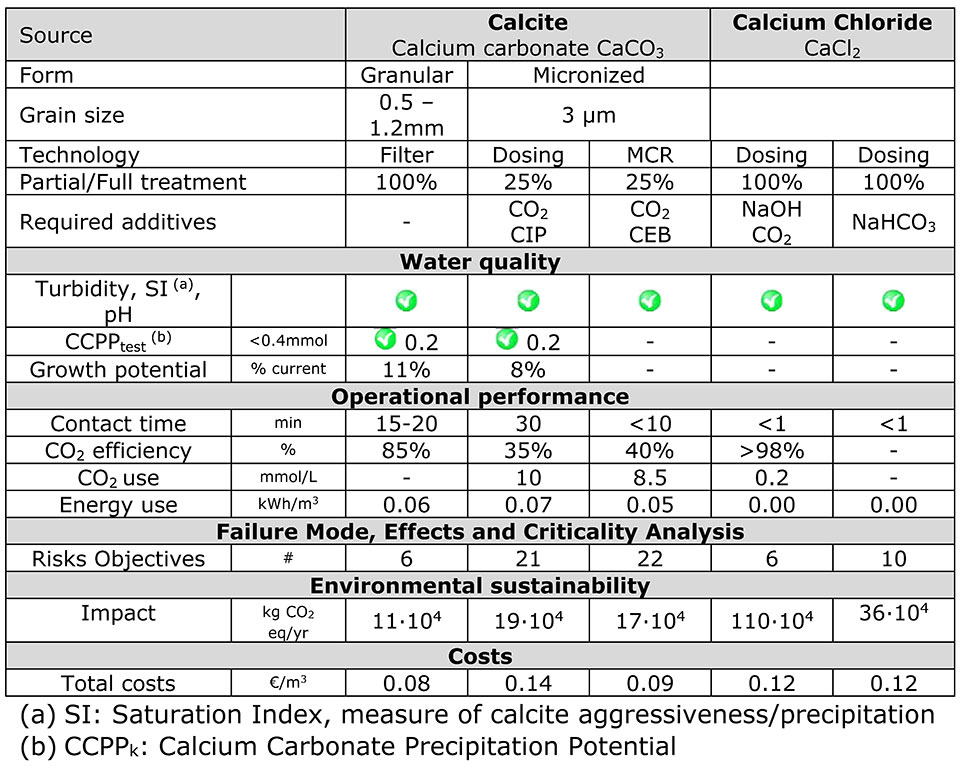
Dutch drinking water manufacturers increasingly come across anthropogenic substances in the water that they extract, such as industrial substances, medicine remains and pesticides. Although the concentrations found are still low, the companies are considering new methods of treatment. The salinization of the groundwater and surface water that has undergone bank filtration also forms a considerable challenge. The question is: what method do you choose to remove those substances optimally and how do you then ensure that the water produced is chemically stable again and meets the legal requirements (remineralisation)?
Evides Waterbedrijf and Oasen Drinkwater carried out almost similar research into the application of remineralisation after treatment of surface water and bank filtered groundwater by means of reverse osmosis (RO). The reason for this is that RO permeate is free of impurities, but chemically not stable. Evides and Oasen carried out their research partly independently and partly collectively. The research questions focused on establishing design parameters for the remineralisation process (such as contact time and efficiency of the use of carbon dioxide), as well as the relation between filtration rate and the required drinking water quality, such as the content of hydrogen carbonate and turbidity. They also considered whether the calcium carbonate precipitation of the water produced meets the set requirements.
Despite the high quality of conventional treatments in the Dutch drinking water preparation, it is not always possible to optimally remove all the anthropogenic substances, and it is not possible to remove salt at all. Although the concentrations of these substances in drinking water are still very low and they do not pose a threat to public health, both companies are preparing themselves for the future. Oasen began in 2012 with the research programme Impeccable water with 100% RO and remineralisation Onberispelijk water met 100% RO en remineralisatie (Flawless water with 100% RO and remineralisation), in order to research and develop the company’s new treatment concept on the basis of membrane filtration. Evides began in 2014 with a company-wide research programme into solutions and applications for the future challenges for the production of drinking water (among other things by means of membrane filtration and remineralisation), industrial water and waste water, including the issues regarding the pipeline network.
Reverse osmosis (RO) is one of the technologies for extensively removing anthropogenic substances and salt. In the Netherlands, this treatment process is applied to a limited extent and usually the permeate is mixed with conventionally treated water. The application of RO for treating fresh river and bank filtered groundwater, for the sole purpose of removing anthropogenic substances from the water, can be called innovative. In the case of RO, a post-treatment is vital for making the water chemically stable and allowing it to meet the legal provisions. This post-treatment is called remineralisation and ensures that the buffer capacity and hardness reach the required standards. In the case of remineralisation, hydrogen carbonate is dissolved in the permeate by means of the contact with calcium carbonate (marble stone). This raw material can dissolve because the lime aggressiveness of the permeate is high, due to the carbon dioxide present. This carbon dioxide can be naturally present or can be added. After the solution reaction, the remaining carbon dioxide can be removed again by means of a degassing process.
For Oasen, the main research question was: What is the best available remineralisation method? All possible technologies for this were charted, then a preselection was made (see Table 1). The application of calcium chloride was eliminated due to the high costs and the high CO2 footprint on the basis of Life-Cycle Analysis (LCA). For the practical research, two techniques remained: (conventional) marble filtration and micro calcite dosage. Marble filtration consists of a dissolution reaction by filtration over marble grains. Micro calcite dosage is the dissolution reaction of marble powder and separation by means of membrane filtration. In the latter case, only the dosage option was tested at pilot level. At the time of the research programme, the option of a Membrane Calcite Reactor (MCR) was still not further developed than at lab scale. This option was therefore eliminated since Oasen wishes to be able to implement the best technique in the short term.

For the pilot research of Evides the main question was: Is it possible to remineralise RO permeate at a low water temperature? And is that a sustainable and workable process? Evides relies largely on surface water from the river Maas, which is stored in the Biesbosch reservoirs in Brabant. The temperature of the surface watercan drop to 2° C during winter time. Little is known about remineralisation at very low temperatures. The question was whether this would have a limiting effect on the reaction kinetics and the dissolution of the minerals required. The optimum operational management and the costs of this process were also considered.
In the pilot set-ups by Evides and Oasen, the various remineralisation techniques on the basis of operational parameters were researched on a scale of 1 to 10 m3 per hour: the efficiency of carbon dioxide usage, energy costs, water quality, failure probability, sustainability and of course the costs. The hypothesis was that marble filtration would not score the best, in particular with regard to the turbidity of the water produced as a result of the leaching of very fine marble particles. However, the research showed that marble filtration still scored the best due to a high water quality, a considerable CO2 efficiency (85-90%) and low calcium carbonate precipitation. Other than expected, the turbidity precisely in the water produced with marble filtration appeared to be minimum. A tasting panel at the University of Wageningen gave a positive assessment about the taste of the ‘new’ water of Oasen.
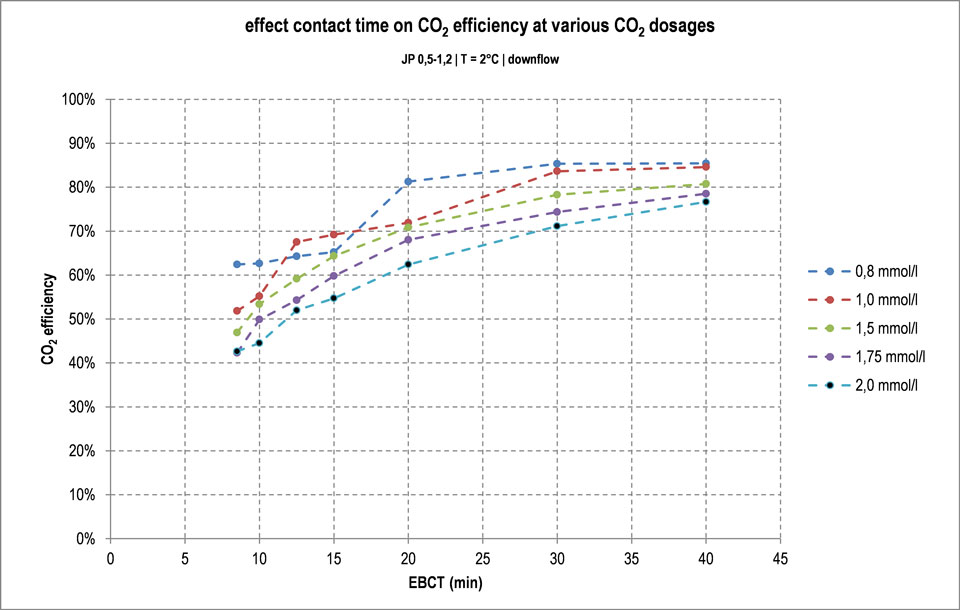
As a result of the four-year research programme of Oasen, marble filtration resulted as the best available technique for remineralisation. The robustness, the high CO2 efficiency and the low turbidity and calcium carbonate precipitation were the deciding factors. Evides and Oasen arrived at the same cost factor: approximately 6 to 8 cent per cubic metre of water produced. As a result, marble filtration is also the cheapest. Marble filtration is therefore the preference and will actually be realized in the near future at one of the treatment plants of Oasen.
After extensive research, the researchers at Evides showed that it is also possible to remineralise permeate at very low water temperatures with practically acceptable contact times and carbon dioxide dosages. It is true that the efficiency decreases in relation to the proces at higher water temperatures, but the water quality standards can be realized without this leading to unacceptably high costs. The design parameters for marble filtration fall within the expected values, with realistic filtration rates and filter bed volumes. The calcium carbonate precipitation of the filtrate was also extensively researched and meets the requirements.
On the basis of the pilot research, Oasen is currently elaborating the complete design for its new treatment plants. In the TKI project Remineralisatie van RO Permeaat (Remineralisation of RO Permeate), in collaboration with KWR Water Research and Royal HaskoningDHV, Oasen has continued with the research into further optimisation and chemical modelling of marble filtration. Evides is using the results of this research within a wider research into future treatment techniques. At Amsterdam International Water Week 2015, Oasen initiated an international session on the theme of remineralisation. In addition, Evides and Oasen both presented their results at the European Desalination Society conference in Rome in 2016. Evides Waterbedrijf and Oasen Drinkwater wish to be ahead of future threats for the drinking water quality. For this reason, they carried out research, partly collectively, into the application of remineralisation for producing drinking water with reverse osmosis (RO). Their research questions focused on establishing design parameters, such as contact time and the efficiency of the use of carbon dioxide, and also focussed on the filtration rate in relation to the quality requirements, such as hydrogen carbonate and turbidity. They also considered whether the calcium carbonate precipitation of the water produced meets the requirements. Both companies found that marble filtration appeared to be the most suitable technique for remineralisation. Oasen will actually realize this technique at one of its treatment plants in the near future. The researchers at Evides showed that it is also possible to remineralise permeate during the winter at very low water temperatures, with practically acceptable contact times and carbon dioxide dosages. Evides is using the results of this research within a wider research into future treatment techniques.
Danny van der Veldt
(Royal HaskoningDHV)
Marleen Heidekamp
(Evides Drinkwaterbedrijf)
Harmen van der Laan
(drinkwaterbedrijf Oasen, H3O.nu)
Pilot columns for marble filtration, part of the fully automatic pilot plant.
Summary
Coppens L. et al. (2014), Impact van RWZI’s op geneesmiddelconcentraties in kwetsbaar oppervlaktewater (Impact of sewage treatment plants on medicine concentrates in vulnerable surface water) (H2O, 26 November 2014)
Houtman, C.J. et al. (2010) Emerging contaminants in surface waters and their relevance for the production of drinking water in Europe, Journal of Integrative Environmental Sciences, 7:4, 271-295, DOI: 10.1080/1943815X.2010.511648
Hamann, E et al. (2016) The fate of organic micropollutants during long-term/long-distance river bank filtration, Sci Total Environ. 2016 Mar 1;545-546:629-40. doi: 10.1016/j.scitotenv.2015.12.057. Epub 2016 Jan 5.
Ter Maat J. et al. (2015) Cumulatieve effecten van externe ingrepen voor de zoetwatervoorziening in de 21e eeuw (Cumulative effects of external interventions for the fresh water provision in the 21st century), Rapport Deltares, Deltaprogramma, Deelprogramma Zoetwater, June 2015 (http://publications.deltares.nl/1220104_000.pdf)
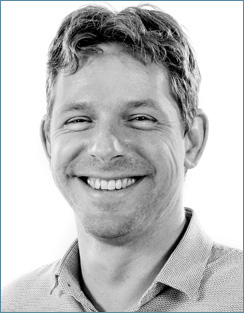
Danny van der Veldt
(Royal HaskoningDHV)
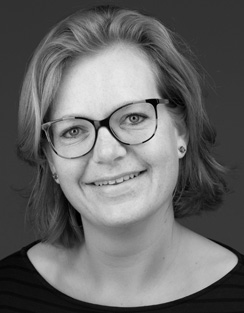
Marleen Heidekamp
(Evides Drinkwaterbedrijf)
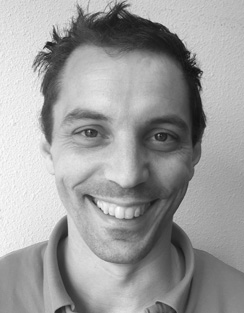
Harmen van der Laan
(drinkwaterbedrijf Oasen, H3O.nu)